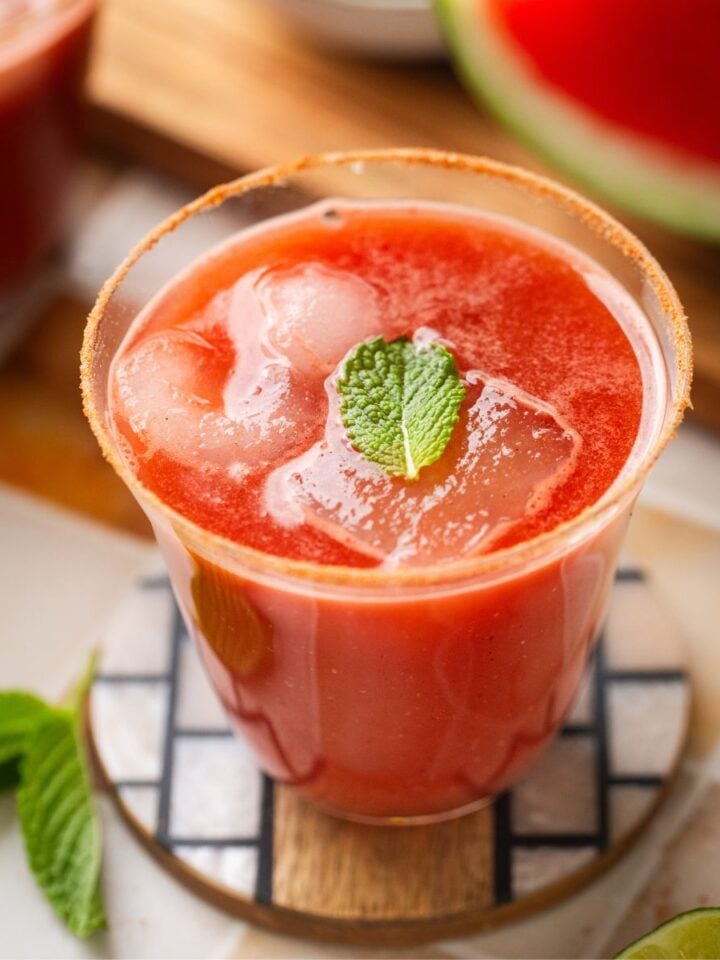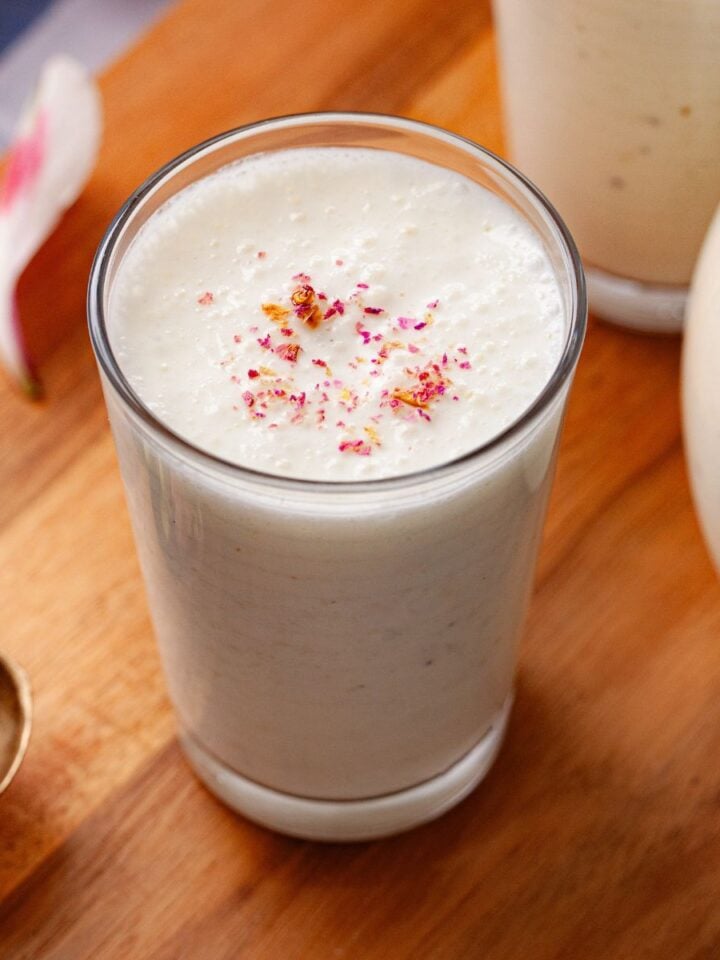Thandai is a traditional Indian drink made with milk, aromatic spices, nuts, and seeds. This refreshing, sweet beverage is especially popular in North India during festivals like Maha Shivratri and Holi (the festival of colors), both of which typically fall during spring.

Our Holi celebration wouldn’t be complete without Thandai! In the weeks leading up to the festival, I prepare a large batch of homemade thandai masala to keep us stocked for a while. Thandai masala is easily available in stores but homemade blend is pure, economical and highly customizable.It’s not just useful for making thandai—this fragrant spice blend adds a delicious twist to desserts like thandai-spiced cookies or , and thandai tiramisu.
What Is Thandai
Thandai is a flavorful drink made with a blend of nuts and spices known for their natural cooling properties. In Hindi, the word "thanda" means cold and it forms the root for "thandak" and "thandai," both of which literally translate to "cooling."
Ingredients like fennel seeds, black peppercorns, white poppy seeds, green cardamom, saffron and rose give it a unique aroma and refreshing taste.
For Holi, a small amount of bhang (derived from cannabis leaves and flowers) is sometimes added to traditional thandai. However, my version is bhang-free which is how we enjoyed it as kids! No spiked version for us!
Tips for The Best Thandai
- Thandai Masala - A well-made thandai masala is the heart and soul of a delicious drink. Take your time to select the freshest nuts and seeds for the best flavor. Invest in high-quality green cardamom, saffron, and rose, as their aroma is just as important as the taste since drinking thandai is a full sensory experience.
- Let It Steep - Overnight is ideal, but I recommend letting it rest for at least 4 hours. Milk is a blank canvas, and this resting time allows the flavors and aroma to deepen and intensify, making your thandai even more delicious!
- Smooth & Creamy - You can strain the steeped thandai for a smoother, silkier texture (though my grandmother would definitely frown at that!) But hey, you do you! My husband prefers it this way, so I often strain it for him.
- Temperature - Thandai is meant to be enjoyed ice-cold—serving it chilled is essential for the ultimate comfort and satisfaction. A warm or room temperature thandai simply doesn’t hit the spot! The colder it is, the creamier and more refreshing it tastes.
Ingredients for Thandai Masala
- Nuts - I use almonds, cashews, and pistachios—though you can add a few walnuts if you prefer. My grandmother always stuck to almonds and cashews. Almonds give thandai its signature wonderful flavor, while cashews lend a creamy richness. I personally add pistachios because I love how they pair with the rose and saffron, adding a unique depth of flavor to the drink.
- Melon Seeds- Traditionally, char magaz (melon seeds) are used and I stick to this classic ingredient. You can easily find them at Indian stores, and they last for 6-8 months if stored in the freezer. If you can’t find melon seeds, you can substitute them with unroasted, unsalted sunflower seeds or pumpkin seeds for a similar texture and flavor.
- White poppy seeds Khus-khus (or Khas-Kash) are the second type of seeds used. White poppy seeds have a mellow, creamy taste that adds depth to the drink. If you can't find white poppy seeds—which are restricted in many countries due to their opium classification—don’t worry, you can simply skip them without affecting the overall flavor too much.
- Spices & Aromatics - Whole black pepper, green cardamom, and fennel seeds are essential spices. I also like to include edible rose petals for a delicate floral note that complements the other flavors beautifully.
- Saffron Strands. Don’t go overboard with saffron—thandai should have a subtle saffron flavor and a pale yellow color, unless you’re specifically making kesar thandai, in which case you can use a little more for a richer flavor and deeper color.
Note -Feel free to customize the flavors and spices to suit your taste. You can add or omit any spices you prefer. If you have kids at home, consider reducing the amount of black peppercorns for a milder masala. You can choose to make either a wet thandai masala or a dry powder. Personally, I prefer making the dry powder because it has a longer shelf life and is more convenient to store.

Thandai Masala Essentials
- You can use the proportions to make both thandai powder as well as wet thandai paste(instructions in subsequent sections).
- I always buy fresh nuts and spices when making thandai masala. You might have nuts sitting in the fridge for months, but for this recipe, I highly recommend using freshly purchased nuts. Since multiple types of nuts go into thandai masala, even one stale, rancid, or bitter nut can ruin the entire batch!
- Be sure to wash the grinder jar thoroughly with warm water and soap, then dry it completely before grinding your masala. Even if you have a dedicated spice jar, you definitely don’t want your thandai masala to pick up the scent of cumin you ground last week, right? Make sure the jar is free from any lingering aromas of other spices to keep your spice blend aromatic and pure.
Instant Thandai Masala Powder
Simply add all the nuts, seeds. and place in a grinder jar. Pulse for about a minute or until you have a powder. Stop occasionally to scrape the sides. Once the nuts are broken down, pulse several times to make as a fine powder as you can. Stopping periodically ensures that the nuts don’t release too much oil and turn pasty. Store the masala in an airtight container for several weeks.


To Make Wet Thandai Paste
Soak the nuts in warm water for about 10 minutes. In another bowl, add the seeds & spices (except saffron & rose) in cold water. Once soaked, if you have time, peel off the skins of almonds and pistachios. I don’t.
Drain and discard the water from both soaked nuts and seeds. Then, add everything(except saffron & rose) to a blender jar, along with a splash of milk. Blend into a thick, fine paste. Transfer to an airtight container and store it in the refrigerator, as it has a shorter shelf life.

How To Make Thandai
- In a large, heavy-bottomed pot, bring the milk to a slow boil on low medium flame. You can also use half-and-half or a combination of milk and evaporated milk for extra creaminess. The creamier the milk, the better the thandai will taste. Keep stirring occasionally to prevent the milk from scorching.
- Reduce the heat to low and add the thandai masala and sugar to the simmering milk. Mix well and let it simmer for 10-15 minutes on low heat. Stir occasionally as it simmers to ensure the flavors blend evenly.


- Take the pot off the stove and allow it to cool for about 10 minutes. Once it’s slightly cooled, mix in the rose water and saffron. Cover the pot and let rest on kitchen counter for flavors to steep for about 1.5 to 2 hours.
- Place the cooled thandai in the refrigerator to steep further.Chill for a few hours or overnight for best flavor.
- Strain and serve chilled. Garnish as desired. Serve thandai with few spoons of rabdi on top for a decadent taste.

Serving & Storing
Pour chilled thandai into drinking cups. Garnish with silvered nuts, rose petals and few strands of saffron. You can add some ice cubes if you wish. It is a perfect make ahead drink. You can prepare it 2-3 days in advance and keep refrigerated. The flavors get better and better! Serve with gujiya for perfect Holi grub!! You can also serve it during peak summer.
Storing Thandai Masala - Store masala powder in air tight container for 6-8 weeks. Store it refrigerated to avoid the nuts from getting smelly. Always use a dry clean spoon to use it. Wet masala can be stored for 3-5 days refrigerated before it changes taste.


Thandai Recipe (With Instant Thandai Powder)
Equipment
- Mixer Grinder
- Sauce Pot
Ingredients
For Instant Thandali Masala Powder (Makes 1 cup, makes extra)
- 40-50 almonds raw
- 20 cashews whole, raw
- 2 tablespoon pistachios raw
- 1.5 tablespoon white poppy seeds
- 1.5 tablespoon fennel seeds
- 25 black peppercorns
- 20 green cardamom pod
- 2 tablespoon dried rose petals
- ½ teaspoon saffron strands
- ¼ teaspoon nutmeg powder optional
For Thandai
- 4 cup whole milk
- ½-3/4 cup thandai powder adjust to liking
- 1 tablespoon rose water optional
- ⅓ cup sugar adjust to taste
Instructions
To Make Thandai Masala
- To Make Instant Thandai Masala Powder, simply add all the nuts, seed and paste to a grinder (I use Vitamix) and grind for 30 seconds. Stop and scrape the sides. Once the nuts have broken down, just pulse several times in intervals of 10-12 seconds. The nuts should be powdered but not release too much oil and turn pasty. Tip: You can roughly chop the nuts before grinding to make it easy on the grinder. To Make Wet Thandai Masala :- Soak the nuts, spices and seeds for 10 minutes in warm water. Drain and discard the water. Add everything to a blender, add 4-5 tablespoon milk (or as needed) and blend into a thick paste. Note:-You can use water to blend.
To Make Thandai
- In a large, heavy-bottomed pot, bring the milk to a slow boil on low medium flame. You can also use half-and-half or a combination of milk and evaporated milk for extra creaminess. The creamier the milk, the better the thandai will taste.
- Keep stirring occasionally to prevent the milk from scorching.Reduce the heat to low and add the thandai masala and sugar to the simmering milk. Mix well and let it simmer for 10-15 minutes on low heat. Stir occasionally as it simmers to ensure the flavors blend evenly.
- Take the pot off the stove and allow it to cool for about 10 minutes. Once it’s slightly cooled, mix in the rose water and saffron. Cover the pot and let rest on kitchen counter for flavors to steep for about 1.5 to 2 hours.
- Place the cooled thandai in the refrigerator to steep further.Chill for a few hours or overnight for best flavor. Strain and serve chilled. Garnish as desired. Serve thandai with few spoons of rabdi on top for a decadent taste.
Notes
- Thandai Masala - A well-made thandai masala is the heart and soul of a delicious drink. Take your time to select the freshest nuts and seeds for the best flavor. Invest in high-quality green cardamom, saffron, and rose, as their aroma is just as important as the taste since drinking thandai is a full sensory experience.
- Let It Steep - Overnight is ideal, but I recommend letting it rest for at least 4 hours. Milk is a blank canvas, and this resting time allows the flavors and aroma to deepen and intensify, making your thandai even more delicious!
- Smooth & Creamy - You can strain the steeped thandai for a smoother, silkier texture (though my grandmother would definitely frown at that!) But hey, you do you! My husband prefers it this way, so I often strain it for him.
- Temperature - Thandai is meant to be enjoyed ice-cold—serving it chilled is essential for the ultimate comfort and satisfaction. A warm or room temperature thandai simply doesn’t hit the spot! The colder it is, the creamier and more refreshing it tastes.






I'd Love to Hear from You!